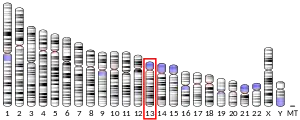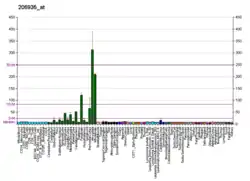PCDH8
Protocadherin-8 is a protein that in humans is encoded by the PCDH8 gene.[5][6][7]
This gene belongs to the protocadherin gene family, a subfamily of the cadherin superfamily. The gene encodes an integral membrane protein that is thought to function in cell adhesion in a CNS-specific manner. Unlike classical cadherins, which are generally encoded by 15-17 exons, this gene includes only 3 exons. Notable is the large first exon encoding the extracellular region, including 6 cadherin domains and a transmembrane region. Alternative splicing yields isoforms with unique cytoplasmic tails.[7]
References
- GRCh38: Ensembl release 89: ENSG00000136099 - Ensembl, May 2017
- GRCm38: Ensembl release 89: ENSMUSG00000036422 - Ensembl, May 2017
- "Human PubMed Reference:". National Center for Biotechnology Information, U.S. National Library of Medicine.
- "Mouse PubMed Reference:". National Center for Biotechnology Information, U.S. National Library of Medicine.
- Strehl S, Glatt K, Liu QM, Glatt H, Lalande M (Dec 1998). "Characterization of two novel protocadherins (PCDH8 and PCDH9) localized on human chromosome 13 and mouse chromosome 14". Genomics. 53 (1): 81–9. doi:10.1006/geno.1998.5467. PMID 9787079.
- Strehl S, LaSalle JM, Lalande M (Oct 1997). "High-resolution analysis of DNA replication domain organization across an R/G-band boundary". Mol Cell Biol. 17 (10): 6157–66. PMC 232466. PMID 9315676.
- "Entrez Gene: PCDH8 protocadherin 8".
Further reading
- Yagi T, Takeichi M (2000). "Cadherin superfamily genes: functions, genomic organization, and neurologic diversity". Genes Dev. 14 (10): 1169–80. doi:10.1101/gad.14.10.1169. PMID 10817752.
- Nollet F, Kools P, van Roy F (2000). "Phylogenetic analysis of the cadherin superfamily allows identification of six major subfamilies besides several solitary members". J. Mol. Biol. 299 (3): 551–72. doi:10.1006/jmbi.2000.3777. PMID 10835267.
- Wu Q, Maniatis T (1999). "A striking organization of a large family of human neural cadherin-like cell adhesion genes". Cell. 97 (6): 779–90. doi:10.1016/S0092-8674(00)80789-8. PMID 10380929.
- Yamagata K, Andreasson KI, Sugiura H, et al. (1999). "Arcadlin is a neural activity-regulated cadherin involved in long term potentiation". J. Biol. Chem. 274 (27): 19473–1979. doi:10.1074/jbc.274.27.19473. PMID 10383464.
- Wu Q, Maniatis T (2000). "Large exons encoding multiple ectodomains are a characteristic feature of protocadherin genes". Proc. Natl. Acad. Sci. U.S.A. 97 (7): 3124–9. doi:10.1073/pnas.060027397. PMC 16203. PMID 10716726.
- Wu Q, Zhang T, Cheng JF, et al. (2001). "Comparative DNA Sequence Analysis of Mouse and Human Protocadherin Gene Clusters". Genome Res. 11 (3): 389–404. doi:10.1101/gr.167301. PMC 311048. PMID 11230163.
- Strausberg RL, Feingold EA, Grouse LH, et al. (2003). "Generation and initial analysis of more than 15,000 full-length human and mouse cDNA sequences". Proc. Natl. Acad. Sci. U.S.A. 99 (26): 16899–903. doi:10.1073/pnas.242603899. PMC 139241. PMID 12477932.
- Bray NJ, Kirov G, Owen RJ, et al. (2003). "Screening the human protocadherin 8 (PCDH8) gene in schizophrenia". Genes, Brain and Behavior. 1 (3): 187–91. doi:10.1034/j.1601-183X.2002.10307.x. PMID 12884975.
- Gerhard DS, Wagner L, Feingold EA, et al. (2004). "The Status, Quality, and Expansion of the NIH Full-Length cDNA Project: The Mammalian Gene Collection (MGC)". Genome Res. 14 (10B): 2121–7. doi:10.1101/gr.2596504. PMC 528928. PMID 15489334.
- Lim J, Hao T, Shaw C, et al. (2006). "A protein-protein interaction network for human inherited ataxias and disorders of Purkinje cell degeneration". Cell. 125 (4): 801–14. doi:10.1016/j.cell.2006.03.032. PMID 16713569.
This article is issued from Wikipedia. The text is licensed under Creative Commons - Attribution - Sharealike. Additional terms may apply for the media files.




